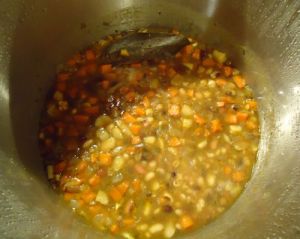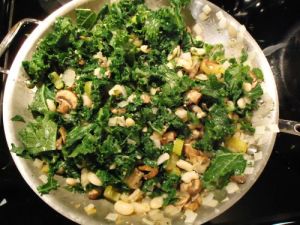Hi, everyone! I am FINALLY back on my blog after several months of radio silence. I’ve been away on campus teaching for the semester, and while I had originally intended to continue posting, there’s not much to say when your primary instrument of cooking is a microwave. (If you were wondering, it is possible to successfully make pasta, beets, potatoes, and a variety of other things in the microwave. But after a while you get lazy and just buy a lot of boxes of soup.) I am super excited to get back to blogging, and I have some awesome recipes coming up including a butternut squash dish, a cake, a salad, at least one type of cookie, and, the subject of today’s post: mushroom barley soup!
I’m a big fan of barley. It is both absurdly healthy and absurdly versatile–you can make it into a breakfast cereal, put it in soups, make it into a risotto, use it as the base of a dish like you would rice or couscous…
Except.
It takes forever to cook.
Oh, the pearled kind cooks up in a perfectly reasonable amount of time, it’s true. But pearled barley doesn’t have nearly the nutritional punch that hulled has, plus it doesn’t have quite the same pleasing, chewy texture.
Solution: slow cooker. With a minimal amount of planning ahead, I pre-cooked the barley overnight in the slow cooker, so that when it came time to make the soup, all I had to do was throw it in. And it’s so easy to make barley in the slow cooker, you can do it while you’re sleeping. Literally. If you cook it on low, it’s ready in 6-8 hours max, which means that this is also an excellent way to replace your breakfast oatmeal with breakfast barley. And in fact, I ended up with more cooked barley than I needed for the soup, so I had ready-made breakfast for the rest of the week!
The soup itself was something I came up with while falling asleep one night–it just popped into my head like a dream and practically wrote itself–when I made the soup a few days later, I felt like I was following a recipe, even though I was making it up. It’s a good soup for a cold winter day–the hearty barley and beans along with the rich mushroom flavor and just a touch of sour cream warms you through without being heavy, and the topping of freshly grated Parmesan adds the perfect amount of umami. (It would be a good thing to enjoy with a nice thick slab of oat soda bread from 101 Cookbooks.)
So here it is, just in time for Christmas:
Mushroom Barley Soup
(Serves 9)
For the barley
- 1 cup dry hulled barley
- 4.5 cups water
For the soup
- 1/4 cup dried porcini mushrooms
- 3/4 cup hot (not quite boiling) water
- 2 tbsp butter
- 1 medium onion, diced
- 1 head of garlic, peeled, smashed, and roughly chopped
- 3-4 cups sliced raw mushrooms (I used a mixture of crimini and white button)
- 1/2 cup dry white wine
- 4 cups mushroom broth
- 1 can of navy beans, drained
- half to all of the cooked barley
- 1 large bunch of kale, chopped into bite-sized pieces
- 1/3 cup sour cream
- salt
- pepper
- Parmesan cheese (for topping)
The night before you plan on making the soup, get out your slow cooker and put in one cup of dried, hulled barley and 4.5 cups of water. Give it a stir (and pick out any bits of chaff that may have been in with your barley), cover it, and set it to low for 8 hours. In the morning, scoop it out, put it in a container, and pop it in the fridge until you’re ready to make the soup.
When you’re ready to make your soup, take your dried porcini mushrooms, put them in a small bowl, and cover them with hot water. Let them steep while you get everything else going. The water should turn a rich shade of reddish-brown, and the mushrooms will re-hydrate.
Meanwhile, in a large stock pot or dutch oven, melt two tablespoons of butter over medium-high heat. When the butter is melted and the pan is hot, add in the diced onion and garlic, and saute until the onion starts to get transparent. Then add the sliced mushrooms, and continue to stir occasionally until the mushrooms start to darken. Deglaze the pan with the white wine, and let it simmer until most of the wine has cooked off.
Chop up the re-hydrated porcini mushrooms and add them to the pan, and strain in the liquid they were soaking in. Add the mushroom broth, beans, and as much of the barley as you would like in your soup (more if you want your soup thicker like a stew, less if you want it more soup-like), and the kale. Cover, and simmer until the kale has completely wilted.
Stir in the sour cream, and then add salt and pepper to taste. It will probably take more salt than you think you need; just add it a little at a time.
Ladle it into bowls, top with Parmesan cheese, and enjoy!










